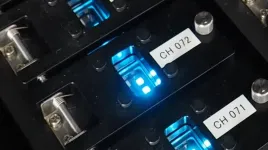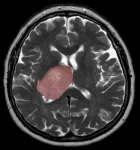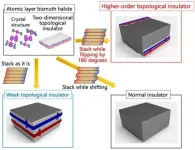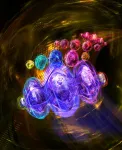(Press-News.org) Polarons are fleeting distortions in a material's atomic lattice that form around a moving electron in a few trillionths of a second, then quickly disappear. As ephemeral as they are, they affect a material's behavior, and may even be the reason that solar cells made with lead hybrid perovskites achieve extraordinarily high efficiencies in the lab.
Now scientists at the Department of Energy's SLAC National Accelerator Laboratory and Stanford University have used the lab's X-ray laser to watch and directly measure the formation of polarons for the first time. They reported their findings in Nature Materials today.
"These materials have taken the field of solar energy research by storm because of their high efficiencies and low cost, but people still argue about why they work," said Aaron Lindenberg, an investigator with the Stanford Institute for Materials and Energy Sciences (SIMES) at SLAC and associate professor at Stanford who led the research.
"The idea that polarons may be involved has been around for a number of years," he said. "But our experiments are the first to directly observe the formation of these local distortions, including their size, shape and how they evolve."
Exciting, complex and hard to understand
Perovskites are crystalline materials named after the mineral perovskite, which has a similar atomic structure. Scientists started to incorporate them into solar cells about a decade ago, and the efficiency of those cells at converting sunlight to energy has steadily increased, despite the fact that their perovskite components have a lot of defects that should inhibit the flow of current.
These materials are famously complex and hard to understand, Lindenberg said. While scientists find them exciting because they are both efficient and easy to make, raising the possibility that they could make solar cells cheaper than today's silicon cells, they are also highly unstable, break down when exposed to air and contain lead that has to be kept out of the environment.
Previous studies at SLAC have delved into the nature of perovskites with an "electron camera" or with X-ray beams. Among other things, they revealed that light whirls atoms around in perovskites, and they also measured the lifetimes of acoustic phonons - sound waves - that carry heat through the materials.
For this study, Lindenberg's team used the lab's Linac Coherent Light Source (LCLS), a powerful X-ray free-electron laser that can image materials in near-atomic detail and capture atomic motions occurring in millionths of a billionth of a second. They looked at single crystals of the material synthesized by Associate Professor Hemamala Karunadasa's group at Stanford.
They hit a small sample of the material with light from an optical laser and then used the X-ray laser to observe how the material responded over the course of tens of trillionths of a second.
Expanding bubbles of distortion
"When you put a charge into a material by hitting it with light, like what happens in a solar cell, electrons are liberated, and those free electrons start to move around the material," said Burak Guzelturk, a scientist at DOE's Argonne National Laboratory who was a postdoctoral researcher at Stanford at the time of the experiments.
"Soon they are surrounded and engulfed by a sort of bubble of local distortion - the polaron - that travels along with them," he said. "Some people have argued that this 'bubble' protects electrons from scattering off defects in the material, and helps explain why they travel so efficiently to the solar cell's contact to flow out as electricity."
The hybrid perovskite lattice structure is flexible and soft - like "a strange combination of a solid and a liquid at the same time," as Lindenberg puts it - and this is what allows polarons to form and grow.
Their observations revealed that polaronic distortions start very small - on the scale of a few angstroms, about the spacing between atoms in a solid - and rapidly expand outward in all directions to a diameter of about 5 billionths of a meter, which is about a 50-fold increase. This nudges about 10 layers of atoms slightly outward within a roughly spherical area over the course of tens of picoseconds, or trillionths of a second.
"This distortion is actually quite large, something we had not known before," Lindenberg said. "That's something totally unexpected."
He added, "While this experiment shows as directly as possible that these objects really do exist, it doesn't show how they contribute to the efficiency of a solar cell. There's still further work to be done to understand how these processes affect the properties of these materials."
INFORMATION:
LCLS is a DOE Office of Science user facility. Lindenberg is also an investigator with the Stanford PULSE Institute, which like SIMES is a joint institute of SLAC and Stanford. Scientists from the University of Cambridge in the U.K.; Aarhus University in Denmark; and Paderborn University and the Technical University of Munich in Germany also contributed to this study. Major funding came from the DOE Office of Science.
Citation: Burak Guzelturk et al., Nature Materials, 4 January 2021 (10.1038/s41563-020-00865-5)
SLAC is a vibrant multiprogram laboratory that explores how the universe works at the biggest, smallest and fastest scales and invents powerful tools used by scientists around the globe. With research spanning particle physics, astrophysics and cosmology, materials, chemistry, bio- and energy sciences and scientific computing, we help solve real-world problems and advance the interests of the nation.
SLAC is operated by Stanford University for the U.S. Department of Energy's Office of Science. The Office of Science is the single largest supporter of basic research in the physical sciences in the United States and is working to address some of the most pressing challenges of our time.
Using a new combination of emitter molecules, researchers in Japan have demonstrated the promise of a novel approach to finally overcome a major challenge facing displays using organic light-emitting diodes: a blue light source matching the excellent performance of the red and green ones.
By splitting energy conversion and emission processes between two molecules, the researchers achieved devices that produce pure-blue emission with high efficiency, maintain brightness for relatively long times, and lack any expensive metal atoms--a set of properties that has so far been difficult ...
Babies who suffer oxygen deficiencies during birth are at risk of brain damage that can lead to developmental delays, cerebral palsy and even death. To prevent this, most women in labor undergo continuous monitoring of the baby's heart rate and receive supplemental oxygen if the heart rate is abnormal, with the thought that this common practice increases oxygen delivery to the baby. However, there is conflicting evidence about whether the long-recommended practice improves infant health.
Now, a comprehensive analysis - led by Washington University School ...
New Columbia Engineering study--first to investigate the long-term effect of soil moisture-atmosphere feedbacks in drylands--finds that soil moisture exerts a negative feedback on surface water availability in drylands, offsetting some of the expected decline
New York, NY--January 4, 2021--Scientists have thought that global warming will increase the availability of surface water--freshwater resources generated by precipitation minus evapotranspiration--in wet regions, and decrease water availability in dry regions. This expectation is based primarily on atmospheric thermodynamic processes. As air temperatures rise, more water evaporates into the air from the ocean and land. Because warmer air can hold more water vapor than dry air, a more humid atmosphere ...
ANN ARBOR, Michigan -- Michael Green, M.D., Ph.D., noticed that when his patients had cancer that spread to the liver, they fared poorly - more so than when cancer spread to other parts of the body. Not only that, but transformative immunotherapy treatments had little impact for these patient.
Uncovering the reason and a possible solution, a new study, published in Nature Medicine, finds that tumors in the liver siphon off critical immune cells, rendering immunotherapy ineffective. But coupling immunotherapy with radiotherapy to the liver in mice restored the immune cell function and led to better outcomes.
"Patients with liver metastases receive little benefit from immunotherapy, a treatment that has been a game-changer for many cancers. Our research suggests ...
MADISON, Wis. -- Deforestation dropped by 18 percent in two years in African countries where organizations subscribed to receive warnings from a new service using satellites to detect decreases in forest cover in the tropics.
The carbon emissions avoided by reducing deforestation were worth between $149 million and $696 million, based on the ability of lower emissions to reduce the detrimental economic consequences of climate change.
Those findings come from new research into the effect of GLAD, the Global Land Analysis and Discovery system, available on the free and interactive ...
COLUMBUS, Ohio - Scientists have developed a machine-learning method that crunches massive amounts of data to help determine which existing medications could improve outcomes in diseases for which they are not prescribed.
The intent of this work is to speed up drug repurposing, which is not a new concept - think Botox injections, first approved to treat crossed eyes and now a migraine treatment and top cosmetic strategy to reduce the appearance of wrinkles.
But getting to those new uses typically involves a mix of serendipity and time-consuming and expensive randomized clinical trials to ensure that a drug deemed effective for one disorder will be useful as a treatment for something else.
The Ohio State University researchers ...
The healing process that follows a brain injury could spur tumour growth when new cells generated to replace those lost to the injury are derailed by mutations, Toronto scientists have found. A brain injury can be anything from trauma to infection or stroke.
The findings were made by an interdisciplinary team of researchers from the University of Toronto, The Hospital for Sick Children (SickKids) and the Princess Margaret Cancer Centre who are also on the pan-Canadian Stand Up To Cancer Canada Dream Team that focuses on a common brain cancer known as glioblastoma.
"Our data suggest that the right mutational change in particular cells in the brain could be modified by injury to give rise to a tumour," says Dr. Peter Dirks, Dream ...
Spintronics refers to a suite of physical systems which may one day replace many electronic systems. To realize this generational leap, material components that confine electrons in one dimension are highly sought after. For the first time, researchers created such a material in the form of a special bismuth-based crystal known as a high-order topological insulator.
To create spintronic devices, new materials need to be designed that take advantage of quantum behaviors not seen in everyday life. You are probably familiar with conductors and insulators, which permit and restrict the flow of electrons, respectively. ...
Some racial and ethnic groups suffer relatively more often, and fare worse, from common ailments compared to others. Prostate cancer is one disease where such health disparities occur: risk for the disease is about 75 percent higher, and prostate cancer is more than twice as deadly, in Blacks compared to whites. Yet whites are often overrepresented as research participants, making these differences difficult to understand and, ultimately, address.
With this problem in mind, scientists at the USC Center for Genetic Epidemiology and the Institute for Cancer Research, London, ...
Last year, more than fifty years after initial theoretical proposals, researchers in Pisa, Stuttgart and Innsbruck independently succeeded for the first time in creating so-called supersolids using ultracold quantum gases of highly magnetic lanthanide atoms. This state of matter is, in a sense, solid and liquid at the same time. "Due to quantum effects, a very cold gas of atoms can spontaneously develop both a crystalline order of a solid crystal and particle flow like a superfluid quantum liquid, i.e. a fluid able to flow without any friction" explains Francesca Ferlaino from the Institute for Quantum Optics and Quantum Information of the Austrian Academy of Sciences and the Department of Experimental Physics at the ...







